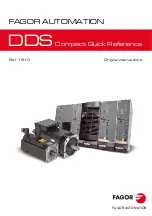
deVIce structure & IsolatIon
~
~
-
+
~
+
U
V
W
J2
DC BUS(+)
DC BUS(-)
940 µF
Regen
L1
MAINS
L3
L2
FEEDBACK
POWER &
DECODING
+5 Vdc
ENABLE [IN1]
SIGNAL GND
CONTROL
SIGNAL
GROUND
CONTROL
RS-232
SYSTEM
J6
J7
J8
3
1
2
BRAKE
CANopen
Network
PE GROUND
PWM
INVERTER
MOTOR
CASE
NETWORK
CAN
XCVR
+24V
24V
POWER
+
-
BRAKE
24V Return
STO_GND
STO_24V
DC/DC
CONVERTER
STO
CONTROL
CONTROL
CORE
RS-232
Interface
4
J3
J5
J1
J4
Cable shield grounding socket
FEEDBACK
ENCODER,
HALLS,
RESOLVER
reGeneraTIon
The chart below shows the energy absorption
in W·s for a
XPC
drive operating at some
typical mains voltages. When the load
mechanical energy is greater than these
values an external regen resistor is available
as an accessory.
0
10
20
30
40
50
60
70
90
100
110
120
130
140
150
160
170
180
190
200
210
220
230
240
250
260
270
Copley Controls, 20 Dan Road, Canton, MA 02021, USA
P/N 16-01436 Rev 01
Page 24 of 28
RoHS
Xenus
PLUS
Compact
CANopen
XPC
drIVe PoWer SourCeS
There are four isolation zones in the XPC:
1.
+24V, brake, & STo
2.
Control circuits, rS-232 & Can comms
3.
High-voltage, regen, & PWm outputs
4.
Canopen communicaions
each of these is isolated from the others and
all are isolated from the chassis.
+24 VdC, brake, & STo
The primary side of the dC/dC converter
operates directly from the external +24
Vdc supply and is isolated from other drive
power sections. Secondary windings provide
power for each isolation zone. The brake
output [ouT6] operates in this section
and is referenced to the +24 Vdc return
(0V). It sinks current from an external load
connected to the ex24 Vdc power
source. The STo circuits also operate from
the 24V power and the STo-24V supplies
current for de-activating (muting) the STo
function when it is not used.
SIGnal and rS-232 CIrCuITS
The signal power section supplies power for
the control circuits as well as the rS-232
communications. motor feedback signals
such as Halls, encoder, and temperature
sensor operate in this section. all signal
circuits are referenced to Signal Ground.
This ground should connect to the control
system circuit ground or common so that
drive and controller inputs and output
voltage levels work properly with each
other.
HIGH VolTaGe, reGen, & PWm
mains power drives the high-voltage
section. It is rectified and capacitor-filtered
to produce internal dC bus which the PWm
stage converts into voltages that drive
either three phase brushless or dC brush
motors. an internal solid-state switch and
power resistor provides dissipation during
regeneration. all the circuits in this section
are “hot”, that is, they connect directly to the
mains and must be considered high-voltages
and a shock hazard requiring proper
insulation techniques during installation.
Can neTWork
The network connections in the Can network
receptacle are optically isolated from the
other drive circuits.
GroundInG
a grounding system has three primary
functions: safety, voltage-reference, and
shielding. as a safety measure, the Pe
(Protective earth) ground at J1-3 will carry
fault-currents from the mains in the case
of an internal failure or short-circuit of
electronic components. Wiring to this is
typically done with the green conductor with
yellow stripe using the same gauge wire
as that used for the mains. This wire is a
‘bonding’ conductor that should connect to
an earthed ground point and must not pass
through any circuit interrupting devices.
All of the circuits on J1, and J2 are mains-
connected and must never be grounded.
The frame ground terminals at J1-3, J1-4,
J2-1, J4-1, J5-1, and J6-1 all connect to
the drive chassis and are isolated from all
drive internal circuits.
Signal grounding references the drive
control circuits to those of the control
system. These controls circuits typically
have their own earth connection at some
point. To eliminate ground-loops it is
recommended that the drive signal ground
be connected to the control system circuit
ground. When this is done the drive signal
voltages will be referenced to the same 0 V
level as the circuits in the control system.
Small currents flow between controller and
drive when inputs and outputs interact.
The signal ground is the path for these
currents to return to their power sources
in both controller and drive.
Shields on cables reduce emissions from
the drive for Ce compliance and protect
internal circuits from interference due
to external sources of electrical noise.
because of their smaller wire gauge,
these should not be used as part of a
safety-ground system. motor cases can
be safety-grounded either at the motor,
by earthing the frame, or by a grounding
conductor in the motor cable that connects
to J2-1. This cable should be of the same
gauge as the other motor phase cables.





































